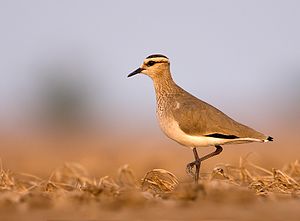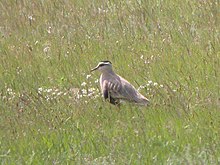Steppe lapwing
| Steppe lapwing | ||||||||||
|---|---|---|---|---|---|---|---|---|---|---|

Steppe lapwing ( Vanellus gregarius ) |
||||||||||
| Systematics | ||||||||||
|
||||||||||
| Scientific name | ||||||||||
| Vanellus gregarius | ||||||||||
| ( Pallas , 1771) |
The steppe lapwing ( Vanellus gregarius ) is a monotypical species from the plover family (Charadriidae). It is a breeding bird of the Eurasian steppe zone , the wintering areas are in North India , Iraq and Eritrea . Occasionally individual birds get lost in Central Europe and join flocks of lapwing there. The IUCN classifies the species as critically endangered because the population has declined dramatically in recent decades.
Appearance
The appearance and appearance is similar to the lapwing. The steppe lapwing reaches a size of 27 to 30 centimeters. The coat, shoulders and chest are gray-brown. In flight, the characteristic three-colored wing pattern with black hand wings , white arm wings and gray-brown cover feathers can be seen. The tail is white with a black end spot (similar to the lapwing).
In the brood plumage, the vertex and eye stripe are black, which means that the white over eye stripe is well separated. The chest turns gray-beige with a slight pink tinge, while the belly is black and turns dark red towards the rump. In the plain dress, the belly is black without, the breast is a lighter gray. The black cap and the black eye stripe are smaller and lighter. Overall, the plumage is more brownish than gray.
This year's steppe lapwing can be recognized by the missing black cap and a yellow-white stripe over the eyes. The chest is dashed faintly gray. The top shows a clear scale pattern.
distribution
The breeding areas are scattered in the Eurasian steppe and dry steppe between the Volga and southwestern Siberia . The largest known breeding occurrences are in Kazakhstan .
The steppe lapwing is one of the short-distance migrants and overwinters mainly in northwest India, Iraq, Israel and Eritrea.
ecology

The steppe lapwing breeds in loose colonies or individually on the ground. He prefers low vegetation , such as can be found in the area of the short grass steppe or on grazed areas. He seems to prefer slightly salty soils and the proximity of water. The exact requirements for the breeding site have only been poorly researched. The largest breeding colonies are found in the vicinity of settlements (due to the grazing there). In its natural environment, the steppe lapwing often brooded on the wintering areas of the saiga antelope ( Saiga tatarica ). Due to their sharp decline, these areas often no longer have the appropriate vegetation height. The wintering areas are dry plains or grasslands, mostly near water.
Danger
In 2003, the steppe lapwing was classified as critically endangered by the IUCN . This highest risk level of the Red List was justified with the drastic decline of the already small population . While 10,000 breeding pairs were counted in 1997, in 2002 only 200 broods were found in the entire breeding area. The population size was therefore estimated at only 600 to 1,800 individuals (source: BirdLife International ). During a study in Kazakhstan in 2006, however, 376 breeding pairs were counted on an area of 145,000 square kilometers. The population estimate was then corrected to 5,600 breeding pairs or 11,200 adult birds.
The causes of the population decline in this species have not yet been finally clarified. Possible factors are missing grazing suitable areas, the increased incidence of the rook ( Corvus frugilegus ) as a nest robber or increasing drought in breeding and wintering areas. The presumed recovery of stocks suggested by the numbers may be related to the abandonment of agricultural land and changes in pasture management after the collapse of the Soviet Union .
literature
- BirdLife International (2000): Threatened birds of the world. Barcelona and Cambridge
- Simon Delany, Derek Scott, Tim Dodman, David Stroud (Eds.): An Atlas of Wader Populations in Africa and Western Eurasia. Wetlands International , Wageningen 2009, ISBN 978-90-5882-047-1 .
Web links
- BirdLife - Birdlife's action plan to save the steppe lapwing
- Vanellus gregarius inthe IUCN Red List of Threatened Species 2018.1. Listed by: BirdLife International, 2016. Retrieved August 31, 2018.
- Videos, photos and sound recordings of Vanellus gregarius in the Internet Bird Collection
Individual evidence
- ↑ a b c BirdLife International: Species Factsheet - Vanellus gregarius

